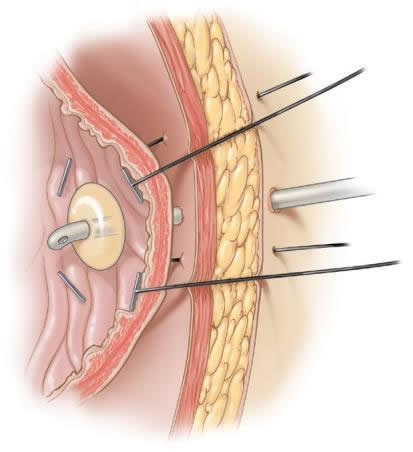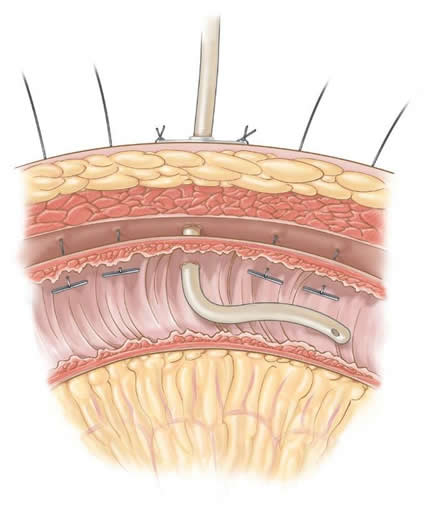Laparoscopic Feeding Gastrostomy or Jejunostomy (feeding tube)
A. The Condition. You may have a condition which prevents you from eating normally; for example, a tumor of your throat. A laparoscopic gastrostomy (or jejunostomy) is a feeding tube which allows your doctor to feed you directly into your intestine with special liquid supplements that will improve your nutritional state.
B. Symptoms
- Nausea and vomiting
- Inability to eat
- Diarrhea
- Weight loss, weakness
C. Laparoscopic Gastrostomy or Jejunostomy. The surgeon will make about 2-3 small incisions in your abdomen. A port (nozzle) is inserted into one of the slits, and carbon dioxide gas inflates the abdomen. This process allows the surgeon to see inside of your abdomen more easily. A laparoscope is inserted through another port. The laparoscope looks like a telescope with a light and camera on the end so the surgeon can see inside the abdomen. Surgical instruments are placed in the other small openings and used to place the feeding tube into your stomach (gastrostomy) or small bowel (jejunostomy). Your doctor will discuss with you before surgery the best place to place the feeding tube. The tube will exit out of your skin, and will be temporarily held in place with four stitches that are attached to half-inch white bolsters on your skin. These stitches will be removed several weeks after surgery. After the tube has been placed, the carbon dioxide is released out of the abdomen through the slits, and then these sites are closed with sutures or staples, or covered with glue-like bandage and steri-strips.
D. Nonsurgical Treatment. Sometimes you can be fed with a tube that is inserted into your nose and down your throat, or by an IV line. Your doctor will discuss with you what is your best option.
E. Risks. The primary risks of laparoscopic gastrostomy or jejunostomy are:
- Infection of the skin at one of the small ports sites
- Leaking of intestinal contents at the insertion site of the tube
- Perforation of the stomach or small bowel
- Collection of pus inside your abdomen (intraabdominal abscess)
- Postoperative ileus (the intestines slow down/stop working for several days)
- Small bowel obstruction (kinking, twisting, or scarring which blocks the bowel)
F. Expectations
1. Before Your Operation. Laparoscopic gastrostomy or jejunostomy usually is an elective procedure. The preoperative evaluation might include blood work, urinalysis, abdominal x-rays, and an abdominal CT scan. You also may have a barium x-ray of your small bowel. If you smoke, then you should stop immediately. If you are taking blood thinners (for example, aspirin, coumadin, Lovenox, or Plavix), then you will need to stop these one week prior to your procedure. Your surgeon and anesthesia provider will review your health history, medications (including blood thinners), and options for pain control.
2. Your Recovery. You usually can go home in 1 or 2 days after a laparoscopic gastrostomy or jejunostomy. Your doctor and/or nurses will instruct you on the use of your feeding tube. You will be given medication for pain. You should limit your activity to light lifting (no more than 15 lb) for one month.
3. Call Your Surgeon if you have one or more of the following:
- Severe pain
- High fever
- Odor or increased drainage from your incision
- No bowel movements for three days
- Nausea, vomiting, and/or crampy abdominal pain
G. Pertinent References
Lorenzo CSF, Murayama KM. “Laparoscopic Feeding Gastrostomy and Jejunostomy.” In: Frantzides CT, Carlson MA, eds. Atlas of Minimally Invasive Surgery. Philadelphia: Saunders Elsevier, 2009.


